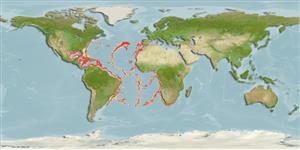>
Aulopiformes (Grinners) >
Ipnopidae (Deep-sea tripod fishes) > Ipnopinae
Etymology: Bathypterois: Greek, bathys = deep + Greek, pterois = with wings (Ref. 45335).
Environment: milieu / climate zone / depth range / distribution range
Ecologia
marino batidemersale; distribuzione batimetrica 800 - 2657 m (Ref. 5320), usually 1200 - 2000 m (Ref. 6688). Deep-water; 40°N - 35°S, 98°W - 30°E
Eastern Atlantic: Off Sierra Leone and Liberia and off South Africa (as Bathypterois ater). Western Atlantic: at bathyal depths between latitude 40°N-5°N including Gulf of Mexico and Caribbean Sea, and off southern Brazil.
Size / Peso / Age
Maturity: Lm ? range ? - ? cm
Max length : 18.0 cm SL maschio/sesso non determinato; (Ref. 3590); common length : 16.0 cm SL maschio/sesso non determinato; (Ref. 3590)
Spine dorsali (totale): 0; Raggi dorsali molli (totale): 13-15; Spine anali 0; Raggi anali molli: 8 - 10. Black in color (Ref. 5320).
Common on mid and lower continental slope. Rests on the bottom with the use of elongated, stiffened outer pelvic and lower caudal fin rays (tripod). Sensory pectoral fins are thrown forward in front of its head, facing the current. Feeds on benthopelagic plankton. Synchronously hermaphroditic (Ref. 6688). Spawning is seasonal with peak during fall in the Bahamas (Ref. 3590).
Life cycle and mating behavior
Maturità | Riproduzione | Deposizione | Uova | Fecundity | Larve
Merrett, N.R., 1990. Chlorophthalmidae. p. 351-360. In J.C. Quero, J.C. Hureau, C. Karrer, A. Post and L. Saldanha (eds.) Check-list of the fishes of the eastern tropical Atlantic (CLOFETA). JNICT, Lisbon; SEI, Paris; and UNESCO, Paris. Vol. 1. (Ref. 3590)
IUCN Red List Status (Ref. 130435)
Threat to humans
Harmless
Human uses
Informazioni ulteriori
Nomi ComuniSinonimiMetabolismoPredatoriEcotossicologiaRiproduzioneMaturitàDeposizioneSpawning aggregationFecundityUovaEgg development
CollaboratoriImmaginiStamps, Coins Misc.SuoniCiguateraVelocitàModalità di nuotoArea branchialeOtolithsCervelliVista
Strumenti
Special reports
Download XML
Fonti Internet
Estimates based on models
Preferred temperature (Ref.
123201): 3.3 - 4.6, mean 4.2 °C (based on 421 cells).
Phylogenetic diversity index (Ref.
82804): PD
50 = 0.5000 [Uniqueness, from 0.5 = low to 2.0 = high].
Bayesian length-weight: a=0.00490 (0.00195 - 0.01230), b=3.03 (2.81 - 3.25), in cm total length, based on LWR estimates for this (Sub)family-body shape (Ref.
93245).
Trophic level (Ref.
69278): 3.4 ±0.45 se; based on food items.
Resilienza (Ref.
120179): Basso, tempo minimo di raddoppiamento della popolazione 4.5 - 14 anni (Preliminary K or Fecundity.).
Fishing Vulnerability (Ref.
59153): Low vulnerability (12 of 100).
